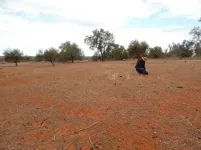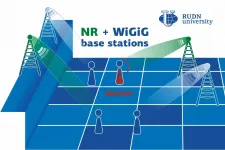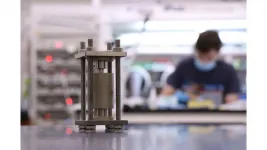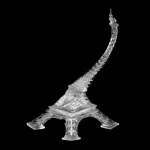(Press-News.org) As a native animal, kangaroos aren't typically considered a threat to Australian vegetation.
While seen as a pest on farmland - for example, when competing with livestock for resources - they usually aren't widely seen as a pest in conservation areas.
But a new collaborative study led by UNSW Sydney found that conservation reserves are showing signs of kangaroo overgrazing - that is, intensive grazing that negatively impacts the health and biodiversity of the land.
Surprisingly, the kangaroos' grazing impacts appeared to be more damaging to the land than rabbits, an introduced species.
"The kangaroos had severe impacts on soils and vegetation that were symptomatic of overgrazing," says Professor Michael Letnic, senior author of the paper and professor in conservation biology and ecosystem restoration at UNSW Science.
"Not only did the areas grazed by overabundant kangaroos have fewer species of plants, but the soils were depleted in nutrients and were compacted - which means that less water can be absorbed by the soil when it rains."
The findings, published late last year in Global Ecology and Conservation, are based on fieldwork conducted in conservation areas during the drought in 2018. The researchers made observations across four conservation reserves in semi-arid parts of the country.
While kangaroos and rabbits can roam freely in these areas, each reserve has several small 'exclosures' - fenced sections designed to keep unwanted animals out - to help native vegetation regenerate. These areas excluded either rabbits, kangaroos, or both.
The team compared the health of the soil and vegetation inside the exclosures with the areas outside. They looked for signs of land degradation specific to each species and monitored animal populations in the area.
Kangaroos were the most populous herbivore across all reserves.
"We tend to think of kangaroo grazing as a natural process because they're a native species, but there are now too many kangaroos in conservation reserves," says Prof. Letnic. "Their grazing can be detrimental for biodiversity conservation.
"We need to start thinking about developing strategies to restore the balance and reduce the adverse impacts of overgrazing - particularly during times of drought."
Dr Graeme Finlayson, SA Arid Rangeland ecologist for Bush Heritage, says overgrazing had dire implications for other native species who rely on vegetation cover and associated food resources to survive. Bush Heritage owns and manages Boolcoomatta Reserve, one of the conservation sites included in this study.
"One of the key species that is likely to be impacted by overgrazing is the critically endangered Plains Wanderer (Pedionomus torquatus), of which there are less than 1000 left in the wild," he says. "Despite sighting three birds at Boolcoomatta in May 2019, monitoring on the reserve has failed to detect any birds since then.
"Overgrazing and then a two-year drought which have greatly reduced cover and food resources are likely to be key drivers behind this."
A dry and delicate ecosystem
Ecosystems are fragile and can be thrown off-balance by an overabundance of one species.
For example, kangaroo overgrazing leads to a lower plant diversity - and fewer plants means less food and shelter for other animals.
Dr Charlotte Mills, lead author of the study and visiting fellow at UNSW Science, hopes that this study paves the way for future research into how threatened species might be affected by kangaroo overgrazing.
"There isn't a lot of research about how kangaroos differentially affect different parts of the ecosystem," she says. "A lot of past research has focused on rabbits."
The team found that rabbits still had negative impacts on the land - for example, there were more woody plants in exclosures that rabbits couldn't get to - but not to the same degree as kangaroos.
"Rabbits and other introduced herbivores like goats are often considered the main contributor to overgrazing in Australia," says Dr Mills.
"But we found kangaroos had a greater impact on the land - and on the grass in particular."
Human intervention is a key contributing factor to the growth of kangaroo populations.
"Humans have been culling dingoes - kangaroos natural predators," says Prof. Letnic.
"We've been making it easier for kangaroos to thrive."
Rethinking conservation practices
Conservation reserves help protect native vegetation from threats like grazing from livestock or introduced species like rabbits or goats.
The findings suggest native species might need to be kept in check, too.
"If we aren't managing threats that have been exacerbated by human activities - such as overabundant kangaroo populations - then we're not using conservation areas in the best way that we can," says Dr Mills.
Prof. Letnic says that while kangaroo populations on farms have been managed for 100 years, they have generally been unmanaged on conservation reserves.
"This research changes thinking by suggesting it's time to ask some questions," he says. "We need to ask whether there are too many kangaroos and if they're having unacceptable impacts on our conservation reserves."
Dr Finlayson says it's a difficult balance to get right, but a humane and science-led approach is best for the entire ecosystem.
"Reducing total grazing pressure clearly has great conservation benefit but can be a challenging issue when this requires the management of native species, such as kangaroos," he says.
"We need to make sure we have a landscape-wide strategy, working across government, conservation and agriculture, to ensure we tackle this problem together, and in the most humane way possible."
INFORMATION:
Mathematicians from RUDN University suggested and tested a new method to assess the productivity of fifth-generation (5G) base stations. The new technology would help get rid of mobile access stations and even out traffic fluctuations. The results of the study were published in the IEEE Conference Publication.
Stations of the new 5G New Radio (NR) communication standard developed by the 3GPP consortium are expected to shortly be installed in large quantities all over the world. First of all, the stations will be deployed in places with high traffic ...
ITHACA, N.Y. -Wind energy scientists at Cornell University have released a new global wind atlas - a digital compendium filled with documented extreme wind speeds for all parts of the world - to help engineers select the turbines in any given region and accelerate the development of sustainable energy.
This wind atlas is the first publicly available, uniform and geospatially explicit (datasets tied to locations) description of extreme wind speeds, according to the research, "A Global Assessment of Extreme Wind Speeds For Wind Energy Applications," published in Nature Energy.
"Cost-efficient expansion of the wind-energy industry is enabled by access ...
One of the most important ways to stop the spread of COVID-19 is for people who have tested positive, or have symptoms, to isolate themselves from the other people they live with.
But a new University of Michigan poll suggests that nearly one in five older adults don't have the ability to do this - and that those who are Hispanic or Black, or who have lower incomes or poor health to begin with, are more likely to lack a safe isolation place in their home.
The poll also shows significant inequality in another key aspect of staying safe and healthy during the pandemic: the ability to get outside for fresh air and exercise, and to engage safely with friends, ...
Despite worldwide use of lithium batteries, the exact dynamics of their operation has remained elusive. X-rays have proven to be a powerful tool for peering inside of these batteries to see the changes that occur in real time.
Using the ultrabright X-rays of the Advanced Photon Source (APS), a U.S. Department of Energy (DOE) Office of Science User Facility at the DOE's Argonne National Laboratory, a research team recently observed the internal evolution of the materials inside solid-state lithium batteries as they were charged and discharged. This detailed 3D ...
The speed of light has come to 3D printing. Northwestern University engineers have developed a new method that uses light to improve 3D printing speed and precision while also, in combination with a high-precision robot arm, providing the freedom to move, rotate or dilate each layer as the structure is being built.
Most conventional 3D printing processes rely on replicating a digital design model that is sliced into layers with the layers printed and assembled upwards like a cake. The Northwestern method introduces the ability to manipulate the original design layer by layer and pivot the printing direction without recreating the model. This "on-the-fly" ...
How do the normal pains of everyday life, such as headaches and backaches, influence our ability to think? Recent studies suggest that healthy individuals in pain also show deficits in working memory, or the cognitive process of holding and manipulating information over short periods of time. Prior research suggests that pain-related impairments in working memory depend on an individual's level of emotional distress. Yet the specific brain and psychological factors underlying the role of emotional distress in contributing to this relationship are not well understood.
A new study, titled "Modeling neural and self-reported factors of affective distress in the relationship between pain and working memory in healthy individuals," and published in the journal ...
LOS ANGELES - New research from the Center for Cardiac Arrest Prevention in the Smidt Heart Institute has found for the first time that during nighttime hours, women are more likely than men to suffer sudden death due to cardiac arrest. Findings were published in the journal Heart Rhythm.
"Dying suddenly during nighttime hours is a perplexing and devastating phenomenon," said Sumeet Chugh, MD, senior author of the study and director of the Center for Cardiac Arrest Prevention. "We were surprised to discover that being female is an independent predictor of these events."
Medical experts are mystified, Chugh says, because during these late hours, most patients are in a resting state, with reduced metabolism, heart rate and blood pressure.
Sudden cardiac arrest-also called sudden cardiac ...
LOS ANGELES (Feb. 3, 2021) -- For the first time in humans, investigators at Cedars-Sinai have identified the neurons responsible for canceling planned behaviors or actions--a highly adaptive skill that when lost, can lead to unwanted movements.
Known as "stop signal neurons," these neurons are critical in powering someone to stop or abort an action they have already put in process.
"We have all had the experience of sitting at a traffic stop and starting to press the gas pedal but then realizing that the light is still red and quickly pressing the brake again," said Ueli Rutishauser, PhD, professor of Neurosurgery, Neurology and Biomedical Sciences at Cedars-Sinai and senior author of the study published ...
NEW YORK and LA JOLLA, CA--A phase 1 clinical trial testing a novel vaccine approach to prevent HIV has produced promising results, IAVI and Scripps Research announced today. The vaccine showed success in stimulating production of rare immune cells needed to start the process of generating antibodies against the fast-mutating virus; the targeted response was detected in 97 percent of participants who received the vaccine.
"This study demonstrates proof of principle for a new vaccine concept for HIV, a concept that could be applied to other pathogens, as well," says William Schief, Ph.D., a professor and immunologist at Scripps Research and executive director of vaccine design at IAVI's Neutralizing Antibody Center, whose laboratory developed the vaccine. "With our many collaborators ...
CHARLOTTE, N.C. - Feb. 3, 2021 - New research on gender inequality indicates that fewer leadership prospects in the workplace apply even to women who show the most promise early on in their academic careers.
Jill Yavorsky, an assistant professor of sociology at UNC Charlotte, co-led the study, "The Under-Utilization of Women's Talent: Academic Achievement and Future Leadership Positions," with Yue Qian, an assistant professor of sociology at the University of British Columbia.
In their paper, published in a leading social science journal, Social Forces, the social scientists discovered that men supervise more individuals ...







